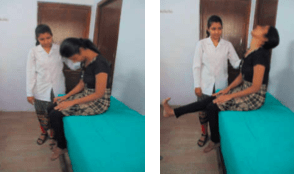During these seven hours, I conducted appointments with three different clients and completed sufficient notes during and after these appointments. The first client was nearly four weeks post lumbar spine surgery, my second appointment was an initial online consultation and the third client appeared to have non specific ankle pain.
Reflective Summary
My first client had been into clinic previously (see reflection); this week the focus was more towards the thoracic spine region rather than the operated area itself. For the majority of the session, posterior anterior (PA) mobilisations were conducted on the costovertebral joints and rib angle. Just lateral to the tubercle is the angle of the rib, which is where the rib has its greatest degree of curvature (Biel, 2014).
The aim of mobilisations is to decrease pain and stiffness therefore improve ROM (Snodgrass & Odelli, 2012). I applied a grade 4 which is a a small amplitude movement stretching into resistance and spasm at the end of the available range (Mahakul, Singh, Sahoo, & Samant, 2017). This was combined with soft tissue massage where positive effects were seen as the clients ROM did increase. Once the tightness had been reduced, it is important to strengthen the area while maintaining the available range. Exercises included standing rows as well as banded and diagonal pull aparts, which were chosen as they avoid any excessive bending, twisting and lifting, all of which the client was told not to do. I also gave the client nerve flossing techniques (NFT) for the sciatic and femoral nerve, as it has been suggested that this movement can relive lumbar radiculopathy (Anikwe, Tella, Aiyegbusi & Chukwu, 2015), which the client is still reporting. A study by Satishkumar, Bid Dibyendunarayan and Thangamani Ramalingam (2017) evaluated the effectiveness of NFT in chronic lumbar radiculopathy. They found that this method of treatment combined with exercise improved pain and passive ROM of hip flexion, which is the movement that the client is currently struggling with.
 Sciatic nerve flossing Satishkumar, Bid & Thangamani Ramalingam, 2017).
Sciatic nerve flossing Satishkumar, Bid & Thangamani Ramalingam, 2017).
My final client presented with non specific ankle pain as there was no apparent pain pattern or aggravating factors / movements. A possible differential diagnosis is arthritis; if this is suspected, the examiner should infer if there is any history of trauma to the area, including fractures or sprains (Hayes, Gonzalez, Smith, Chiodo & Bluman, 2016).My client had previously broken this ankle, which affects the movement at the joint.
What Went Well
For my final client, I was informed that they wanted to have a fitness session with me, however once the client got to clinic I found out they had pain around the ankle. This meant that I had to adapt the session quickly so it was specific to the clients complaint. Despite feeling panicked that I had to change the session so quickly, I manage to conduct it effectively.
| Areas for Improvement | Action Plan |
| Practice hand positioning for mobilisations at each joint. | Once I am able to return to my clinical placement, I will be able to practice these techniques with my supervisor. |
| Have a greater understanding of different pathologies that can occur in and around the foot. | Research the common pathologies related to this areas along with the common signs and symptoms. |
Closing the Loop
Since writing this reflection, I have had the opportunity to continue to develop my manual therapy techniques, while working in a clinical environment.
References
Anikwe, E. E., Tella, B. A., Aiyegbusi, A. I., & Chukwu, S. C. (2015). Influence of Nerve Flossing Technique on acute sciatica and hip range of motion. International Journal of Medicine and Biomedical Research, 4(2), 91-99.
Biel (2014). Trail guide to the body: A hands on guide to locating muscles, bones and more. Boulder, USA: Books of Discovery.
Hayes, B. J., Gonzalez, T., Smith, J. T., Chiodo, C. P., & Bluman, E. M. (2016). Ankle arthritis: you can’t always replace it. Journal of the American Academy of Orthopaedic Surgeons, 24(2), e29-e38.
Mahakul, B., Singh, H., Sahoo, J., & Samant, S. (2017). Effectiveness of Maitland mobilisation technique on pain and hand functions in the postoperative management of Colles fracture. International Journal of Orthopaedics Sciences, 3(3), 397–399.
Satishkumar, B. S., Bid Dibyendunarayan, D., & Thangamani Ramalingam, A. (2017). Effectiveness of Nerve Flossing Technique in Chronic Lumbar Radiculopathy. Indian Journal of Physiotherapy and Occupational Therapy, 11(1).
Snodgrass, S. J., & Odelli, R. A. (2012). Objective concurrent feedback on force parameters improves performance of lumbar mobilisation, but skill retention declines rapidly. Physiotherapy, 98(1), 47–56.
